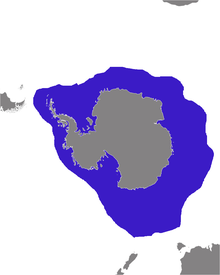Leopard seal
| Leopard seal Temporal range: 5–0 Ma Early Pliocene – Recent |
|
|---|---|
 |
|
| Scientific classification | |
| Kingdom: | Animalia |
| Phylum: | Chordata |
| Class: | Mammalia |
| Order: | Carnivora |
| Family: | Phocidae |
| Subfamily: | Monachinae |
| Tribe: | Lobodontini |
| Genus: |
Hydrurga Gistel, 1848 |
| Species: | H. leptonyx |
| Binomial name | |
|
Hydrurga leptonyx (Blainville, 1820) |
|
 |
|
| Hydrurga leptonyx range map | |
| Synonyms | |
|
|
The leopard seal (Hydrurga leptonyx), also referred to as the sea leopard, is the second largest species of seal in the Antarctic (after the southern elephant seal). Along with all of the other earless seals, it belongs to the family Phocidae, and is the only species in the genus Hydrurga. The name hydrurga means "water worker" and leptonyx is the Greek for "small clawed".
The leopard seal is large and muscular, with a dark grey back and light grey on its stomach. Its throat is whitish with the black spots that give the seal its common name. Females are slightly larger than the males. The overall length of this seal is 2.4–3.5 m (7.9–11.5 ft) and weight is from 200 to 600 kilograms (440 to 1,320 lb). They are about the same length as the northern walrus, but usually less than half the weight.
Its front teeth are sharp like those of other carnivores, but its molars lock together in a way that allows them to sieve krill from the water, in the manner of the crabeater seal.
The leopard seal lives in the cold waters surrounding the Antarctic continent. Where most seals remain restricted within the pack ice throughout the year, some (mostly young animals) move further north in the austral winter to subantarctic islands and the coastlines of the southern continents. They are difficult to survey by traditional visual techniques because they spend long periods of time vocalizing under the water during the austral spring and summer - when visual surveys are carried out. This trait of vocalizing underwater for long periods however has made them available to acoustic surveys. Leopard seals are and widely distributed throughout the pack ice. Higher densities of leopard seals are seen in the Western Antarctic than in other regions.
Leopard seals are very vocal underwater during the austral summer. The male seals produce loud calls (153 to 177 dB re 1 μPa at 1 m) for many hours each day. While singing the seal hangs upside down and rocks from side to side under the water. Their back is bent, the neck and cranial thoracic region (the chest) is inflated and as they call their chest pulses. Adult male leopard seals have only a few stylized calls, some are like bird or cricket-like trills yet others are low haunting moans. The leopard seals have age-related differences in their calling patterns, just like birds. Where the younger male seals have many different types of variable calls - the adult male seals have only a few, highly stylized calls. Each male seal produces individually distinctive songs. They arrange their few call types into individually distinctive sequences (or songs). The acoustic behavior of the leopard seal is believed to be linked to their breeding behaviour. In male seals, vocalizing coincides with the timing of their breeding season, which falls between November and the first week of January; captive female seals vocalize when they have elevated reproductive hormones.
...
Wikipedia

